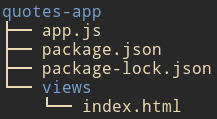How to Add Bootstrap to your Nodejs Project
May 26, 2020
If you’re building apps with Nodejs and feel like you need a tool to help you enhance the UI, this article is for you. It will guide you step by step on how you can add Bootstrap to your Nodejs.
Let’s create a simple app that contains the text Hello the World in a Bootstrap jumbotron.
The Initial Project
Create a simple Node project like the one below.
Nothing tricky here. Create a folder for your project and initialize it as Node project, npm init -y. Create the server file, app.js (touch app.js), and other directories (mkdir views).
Let’s install express to configure a lightweight Node server.
npm i express or yarn add express.
We can now create our basic server.
const express = require("express")
const path = require("path")
const app = express()
app.get("/", (req, res) => {
res.sendFile(path.join(__dirname, "views/index.html"))
})
app.listen(5000, () => {
console.log("Listening on port " + 5000)
})We are listening on port 5000 and serving up index.html file. Make sure you have it created already and add some html contents in it.
Start your server (node app.js) and see if everything is OK. If so, let’s move to the next session.
Adding Bootstrap CSS
The first solution I’d suggest here is to use a CDN. Here’s how you can do it.
Go here to copy Bootstrap CSS and eventually additional JS and paste them in your index file.
Using a CDN
Now is the time to modify our index.html so that we can add Bootstrap CSS.
<!DOCTYPE html>
<html lang="en">
<head>
<!-- Required meta tags -->
<meta charset="utf-8" />
<meta
name="viewport"
content="width=device-width, initial-scale=1, shrink-to-fit=no"
/>
<!-- Bootstrap CSS -->
<link
rel="stylesheet"
href="https://stackpath.bootstrapcdn.com/bootstrap/4.5.0/css/bootstrap.min.css"
integrity="sha384-9aIt2nRpC12Uk9gS9baDl411NQApFmC26EwAOH8WgZl5MYYxFfc+NcPb1dKGj7Sk"
crossorigin="anonymous"
/>
<title>Hello, the world!</title>
</head>
<body>
<div class="jumbotron">
<div class="container"><h1>Hello, the world!</h1></div>
</div>
<!-- Optional JavaScript -->
<!-- jQuery first, then Popper.js, then Bootstrap JS -->
<script
src="https://code.jquery.com/jquery-3.5.1.slim.min.js"
integrity="sha384-DfXdz2htPH0lsSSs5nCTpuj/zy4C+OGpamoFVy38MVBnE+IbbVYUew+OrCXaRkfj"
crossorigin="anonymous"
></script>
<script
src="https://cdn.jsdelivr.net/npm/popper.js@1.16.0/dist/umd/popper.min.js"
integrity="sha384-Q6E9RHvbIyZFJoft+2mJbHaEWldlvI9IOYy5n3zV9zzTtmI3UksdQRVvoxMfooAo"
crossorigin="anonymous"
></script>
<script
src="https://stackpath.bootstrapcdn.com/bootstrap/4.5.0/js/bootstrap.min.js"
integrity="sha384-OgVRvuATP1z7JjHLkuOU7Xw704+h835Lr+6QL9UvYjZE3Ipu6Tp75j7Bh/kR0JKI"
crossorigin="anonymous"
></script>
</body>
</html>I added two Bootstrap classes: container and jumbotron.
Restart your server and go check if Bootstrap is on the page (just see if a fluid jumbotron is there).
This solution is good, but when working offline, you’ll be limited. That’s why I want you to test the next solution.
Using npm
The first thing you have to do hear is to install packages, which are bootstrap and optionally jquery.
npm i bootstrap jquery --save
To make use of these files we have to modify our app.js so that it will serve them to us.
// app.js
const express = require("express")
const path = require("path")
const app = express()
app.use(
"/css",
express.static(path.join(_dirname, "node_modules/bootstrap/dist/css"))
)
app.use(
"/js",
express.static(path.join(_dirname, "node_modules/bootstrap/dist/js"))
)
app.use("/js", express.static(path.join(_dirname, "node_modules/jquery/dist")))
app.get("/", (req, res) => {
res.sendFile(path.join(__dirname, "views/index.html"))
})
app.listen(5000, () => {
console.log("Listening on port " + 5000)
})Thanks to express.static() we are able to serve up Bootstrap without any difficulty.
Now we can make use of Bootstrap in our HTML pages by just linking to it as <link rel="stylesheet" href="./css/bootstrap.min.css">.
Conclusion
In this article, we learned how to integrate Bootstrap in our Nodejs project in two different ways. The first way is to use official CDN and the last one to use npm. This last solution is suitable if you’re working locally (and offline).
Do you have another you to work with Bootstrap in a Node project? Share with us!
